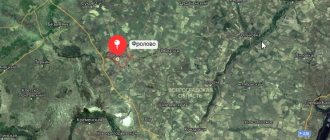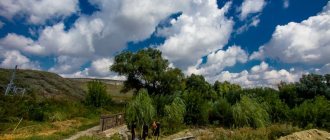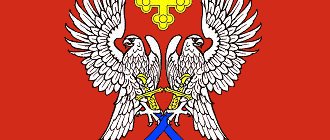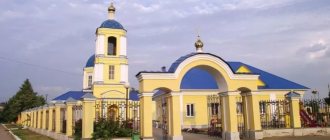Volgograd is located very well. The regional center unites a region that covers the southeast of the European Russian Federation. The area runs in the direction from north to south and from west to east. The total length of the borders of the region under consideration is 221.9 km. There is contact with the borders of the following regions:
- Saratov region is the northern border (approximately 30% contiguous).
- Voronezh region - northwestern section (common border more than 11%);
- Rostov region - western and southwestern perimeter (combines 27% of the common border);
- Astrakhan region - southern and south-eastern direction (more than 11% of the total border);
- Republic of Kalmykia – southern part (combines 11% of the border);
- Kazakhstan – eastern section (10% of the border connected).
Volgograd serves as the administrative center of the region. The total area of the hero city is 859 square kilometers.
Flag of Volgograd: heraldry today and history
The region has an advantageous location in terms of geography. On the one hand, the region allows access to the southern part of the Russian Federation. As a result, access to the border zone of neighboring states, namely Iran, the Caucasus, Ukraine and Kazakhstan, is opened. On the other side is the center of the Russian Federation and the Volga region. The perimeter in question crosses an important body of water. The Volga-Don Canal is based on two key reservoirs - the Volga and Don, respectively. This arrangement opens up new perspectives. There is access to several water resources, namely the Caspian, White, Baltic, Black and Azov seas.
The total perimeter of the region is approximately 113,000 square kilometers. About 78% of this area is in the agricultural sector.
Climatic conditions
Volgograd and the region are located in the continental climate zone. An arid atmosphere prevails in the region. The northwestern section is occupied by forest-steppe, and the east belongs to the semi-desert region, which in some places borders on the category of complete desert. For almost the entire month of January, average temperatures are 8-12 degrees below zero. In July, the air temperature rises to 23-25 degrees above zero.
In the northwestern part, about 500 mm of precipitation falls, and in the southeast this figure is less than 300 mm. The maximum air temperature can reach +44 degrees. Most often, an abnormal increase in the indicator occurs in July-August. Minimum temperatures can reach -42 degrees. Such cold weather occurs in January-February.
Winter precipitation in the region occurs within 90-110 days. During this time, up to 22 cm of snow may fall. For many years, researchers have been monitoring the stability of snow cover.
As a result, it was possible to find out that in the North and South, winter precipitation lasts for different periods of time. For the northern part, this indicator falls on December 11-17, and in the south – on December 20-25.
On the territory of Volgograd and the region, the winter period most often begins in December. It lasts 70-90 days. Spring is quite short. It starts in March-April. Sometimes there are frosts in May. This phenomenon causes significant damage to agricultural vegetation and local gardens.
The actual onset of summer generally occurs in May, but there are times when the final warmth begins in June. Summer lasts approximately 3.5 months. Autumn is quite big. It begins in the second part of September and lasts until the first half of December. Situations are often observed when frosts begin to form in October.
Marriages and divorces
In 2021, the number of divorces became several times higher than in 2021. From official data, disappointing statistics were obtained: out of 566 marriages registered in the city, there were 804 divorces. If we take into account that in the first month 219 were registered - 577 divorces.
Divorces happen for various reasons, especially many cases were registered during the period of coronavirus infection; most families, without full-fledged income, were left in a difficult situation, which led to stressful situations and a vulnerable financial situation. The increase in divorces exceeded the bar already in June.
Data for the Volgograd region
Mamaev kurgan
The most important and at the same time the most mournful memorial complex in Russia is located in the central part of Volgograd on an elevation of about 100 meters. The complex immortalized the memory of the tragic events of the Battle of Stalingrad in the place where more than 35 thousand defenders were killed.
The path to the top of Kurgan lies through 200 steps, each of which symbolizes one day of the defense of Stalingrad from the German invaders.
High relief “Memory of Generations”
This is the introductory composition of the grand memorial. The large wall depicts women, children, men and old people walking with wreaths and flowers to the steps of the Kurgan with their heads bowed. They seem to show the heroes of the battle that their feat will never be forgotten.
Alley of Poplars
The path to the next level of Mamayev Kurgan lies through the Alley of Pyramid Poplars. Like a company of soldiers, they lined the green corridor to honor the memory of the dead.
Square of Those Who Stood to the Death
The area is a square with a shallow pool in the center. In the middle of the reservoir there is a rock from which grows the image of the hero-defender of the Stalinist battle.
Ruin walls
The walls reproduce pictures of a brutal and bloody battle. You can look at the chronicle endlessly! There are loudspeakers installed inside the wall, from which the sounds of gunshots and explosions are heard, and war songs are also played.
Heroes Square
The steps of the ruin walls lead visitors to the largest area of the memorial. Most of the space is occupied by a swimming pool, which is unofficially called the Lake of Mother's Tears. On the left side there is a banner wall. And opposite are six figures personifying heroism, military spirit and duty to the Motherland.
Square of Sorrow
Above the Square of Heroes is the Square of Sorrow. The most famous monument, which makes a huge impression on visitors, is the sculpture “Mother’s Sorrow”. Marshal Chuikov was buried in this place (of his own free will).
The Motherland is calling!
At the top of Mamayev Kurgan there is a famous monument to Russia - a figure of a woman called “The Motherland Calls”. It is the tallest monument in the country and also the tallest non-religious figure in the world. Its height together with the pedestal is 87 meters.
Church of All Saints
The temple was erected in 2006 and today it acts as one of the monuments to the fallen soldiers, who, according to church canons, are recognized as holy great martyrs. In the temple you can light a candle for the repose of the victims of the battle.
7 most beautiful Orthodox churches in Russia
Panorama Museum Battle of Stalingrad
The museum building is a grandiose cylindrical structure. The museum presents the greatest exhibition dedicated to the events of the Battle of Stalingrad. An impressive 360-degree panorama unfolded at the top of the building.
The museum complex also includes other attractions of Volgograd:
- the ruins of the Gerhardt mill - a building that preserves traces of fierce street battles;
- fountain “Dancing Children” ;
- monument to Marshal Zhukov ;
- exhibition of military weapons dedicated to the events of the Civil War.
Environmental problems of the river
The ecology of the river needs protection. The influence of man on her is great and detrimental. Unfortunately, about thirty percent of all garbage ends up in this great river, and the environmental issue is quite acute here. Many species of various flora and fauna are dying.
Some fish species undergo severe mutation, and algae grow too rapidly. Various steps are being taken to preserve the environment: for example, in 2008, UNESCO organized the “Living Volga” project, and the “Great Rivers” forum was also held. The future of the river is in the hands of generations who are not indifferent to this problem.
History of Volgograd
Main milestones in the history of Volgograd:
- founded in 1555 on the island as a fortress on the trade route between Rus' and the East;
- 16-18 centuries looting and destruction by Stenka Razin, then peasant wars;
- late 18th-early 19th century – development of industry, large transport hub;
- 1920s - terrible famine, disease and pestilence;
- 1941-1945 – WWII, the Germans tried to capture the city in order to cut off the route with oil and food from the Caspian Sea to the center of the country;
- Soviet period - city restoration, industrial development.
Now Volgograd is considered the poorest city, where the population is over 1 million people. Agriculture and industry are not using even 50% of their potential.
There are many opportunities to visit Volgograd; the city is reached by waterway, air and railway connections, and a highway. The ideal time for a trip is the end of spring, summer, beginning of autumn, when it is warm and you can walk around the city endlessly and try the gifts of nature to your heart’s content - fish, ripe vegetables and fruits.
What do we know about the Volga?
It can rightfully be considered one of the largest rivers on Earth. It flows through Russia and Kazakhstan, heading towards the Caspian Sea. The Volga is considered an important artery for Russian shipping. Its length is more than three and a half thousand kilometers, and more than a thousand different small rivers flow into it.
Why is the river so full? This happens due to snow melting. Floods are high and may continue until mid-June, causing concern to the relevant services. That is why, to tame the waves, so many reservoirs were placed on it.
Central Embankment
The embankment of the 62nd Army is located in the central area of the city, here you can admire the landscapes of the Volga and take a ride on a cruise ship to the Volzhskaya hydroelectric station.
The Alley of Heroes, 360 meters long, connects the embankment with the very center of the city, zero kilometers, and the eternal flame. Next to it is a unique natural monument, the Poplar on the Square of Fallen Fighters, which carried its life through the great battle.
It’s especially beautiful here in the evening, when the lampposts light up and the alley becomes more than just a boulevard in the city center.
Train Station
The Volgograd railway station cannot be called an outstanding architectural structure, but it, like everything else, is important for the city. In 2013, a duplicate of the Barmaley fountain was installed near the central entrance, which delighted residents in the pre-war period. During the Soviet Union, they were installed in many cities.
Light Rail
The Volgograd high-speed tram is a kind of hybrid of the metro and a regular tram. The route layout is quite simple, there is only one branch that goes along the Volga. This type of transport is considered the most convenient for tourists; it allows you to visit the most important places in the city. Its significance is recognized not only by city residents, but also by the editors of Forbes magazine, which included it in the list of the 12 most interesting tram routes in the world.
Panorama Museum "Battle of Stalingrad"
The main museum dedicated to the Great Patriotic War, which consists of 8 halls. You won’t be able to quickly walk through them; the abundance of exhibits, personal belongings of soldiers, and real photographs will make you linger here for the whole day.
An interactive map of the city is one of the main exhibits; with the help of projection, military actions are reproduced and the city seems to come to life. On the top floor of the museum there is a panoramic canvas, 16 meters high and 120 meters long. It mainly shows the final stage of the War, Operation Ring.
City infrastructure
Finding a place to stay in Volgograd is not difficult. There are many hotels of different levels here. You can also rent an apartment (find out more), which is even cheaper, considering that you can cook your own meals instead of paying extra in a cafe or restaurant.
Transport system
In recent years, Volgograd's transport system has improved significantly. New buses have appeared on routes, modern stops have appeared with information boards and transport arrival times. This is a definite plus for tourists and foreigners.
Barge Haulers on the Volga
It was on the Volga that such an old profession as barge hauler appeared. Many strong young men pulled ships along its banks. They worked only in spring and autumn, during major floods. Interestingly, sometimes more than 500 thousand barge haulers worked on the river. They walked on average up to ten kilometers a day. The merchants gave the families of hard workers a large advance so that they could last without their father for the entire long period of work.
Of course, this profession was extremely difficult and required great strength and endurance. In an artel of barge haulers there was always a leader, who was called a “big shot.” He walked at the head of the column, encouraging the others. In the middle of the crowd were the so-called “bonded” - lazy random people, and the last of the procession were the “zealous”, those who had arrived recently.
- It is interesting that, inspired by the beauty of the Volga, many Russian poets dedicated their poetic lines to it. So, Yevtushenko and Nekrasov wrote about her, Repin and Savrasov painted her.








